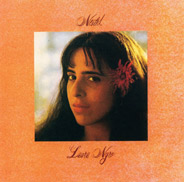
Laura Nyro
Nested
(Iconoclassic)
Showing a peculiar, soft kind of grace all its own that definitely
makes it a one of a kind item in Nyro’s discography, Nested has nonetheless suffered
from a strange, and in many ways quite difficult to understand, process
of undervaluation when it comes to its physical presence in the marketplace
(here I’m taking for granted the album’s high quality in terms of both
composition and performance), it being the only album from Nyro’s "classic"
period not to have been re-released in digital form – not for long, anyway,
a Japanese CD edition having been on sale just for a short while.
This
is precisely the kind of fact that makes any Nyro’s fan upset. For a start,
its being out of print has deprived newcomers of an important piece of
the puzzle (and it has to be said that Nested is not one of those "impossibly
rare" albums whose being "impossible rare" proves to be
the only reason for their being a precious "object of desire" as
soon as one has actually forked their money). Sure, there are also more
self-centered reasons for a fan being upset: not many vinyl albums sound
as muffled and cloudy as Nested; so one has to be curious about what a
new (and improved?) digital master could reveal.
Originally
released in 1978, Nested was destined to be the last episode in the second
chapter of Nyro’s musical history. Coming six years after her last studio
album featuring original material, the indispensable Christmas And The
Beads Of Sweat (also five years after the release of Gonna Take A Miracle,
where Nyro revisited songs that had proved to be influential for her artistic
growth), Smile (1976) was a return to form that signaled her return to
the stage, as witnessed by the fine live album Season Of Lights. When recording
Nested, Nyro chose a "home recording" framework – here listeners
will find some very useful liner notes by Michele Kort, who wrote the fine
Nyro biography Soul Picnic.
Nested
inhabits an aesthetic dimension that can be defined as "relaxed funk".
On one hand, here we can find Laura Nyro’s peculiar traits, with the featured
musicians adding a "sleek, modern" kind of surface which reveals
some very fine instrumental touches. And let’s not forget Nyro’s performances
on the Fender Rhodes electric piano, also adding to the
"funk". There’s a nice rhythmic pulse from drums (Andy Newmark)
and percussion (Nydia "Liberty" Mata). Fine guitars throughout:
acoustic and electric guitars, often layered, sometimes playing nervous arpeggios
– there are also parts played bottleneck slide on acoustic, and an overdubbed
solo somewhat reminiscent of Larry Carlton (guitars are played by a young
Vinnie Cusano and veteran John Tropea). There are also a few "special
participation moments": John Sebastian playing harmonica on one track,
Cyril Cianflone and Tony Levin on bass (one track each), Felix Cavaliere
on electric piano and organ on two tracks. Special mention, however, has
to go to the electric bass played by Will Lee (sounding to me like a Fender
Jazz Bass with flatwound strings). The only instrumental voice that was clearly
audible on the old vinyl LP, Lee’s electric bass is a model of dynamic performance,
with impeccable attack and release; always reliable when it comes to pulse,
it’s not shy when it comes to melodic counterpoint.
First
track Mr. Blue is a ballad that works perfectly as an introduction, Nyro
on acoustic guitar and string ensemble; listen carefully for those funky
guitar accents under "This is the song of communications". Grand
piano, electric bass and harmonica are the main instrumental voices of
Rhythm &
Blues, which sports a contagious groove. The arrangement of the instrumental
part at the end of My Innocence has always reminded me of The Doors circa
LA Woman, but the composition and the vocal melody are pure Nyro. A tense
ballad for solo piano and vocals, Crazy Love is the dramatic peak of the
album. Sporting an elastic groove, electric piano, and agile bass, American
Dreamer manages to sound quite "light" though its topic is quite
serious – a potential single, and the perfect close to Side One.
Springblown
is a perfect Side Two opener: relaxed, with acoustic guitars, bass, percussion,
it has some quite live-sounding accelerandi. The Sweet Sky can only remind
one of "classic" Nyro, with electric piano by Felix Cavaliere,
a mood that’s almost-Gospel, and layered vocals. Having what to me sounds
like a loop of maracas as its foundation, and an electric piano in the
foreground, Light – Pop’s Principle is the best example of the album’s "slick
funk". Child Of The Universe has some "up-tempo" moments
that reminded me of Carole King (Newmark’s drums resembling Russ Kunkel’s).
The Nest is the beautiful closing track: Cavaliere’s organ, phased guitars,
and a moving vocal performance on an album that has lots of them.
The
colour of the booklet cover – the pink from the old LP having changed to
an
"orange-salmon" – is the only wrong thing with this re-release.
The digital re-master – by Vic Anesini – sounds really good. Taking the old
vinyl sounding bad as a fact, I am happy to see that it was the mastering
process that was at fault, and not the original master tape. Nyro’s vocals
(lead, counterpoint, and background) are always clear and beautiful, guitar
lines are easy to spot, the bass sounds loud but not too loud, keyboards
and all "special touch" are comme il faut. It goes without saying
that clear loudspeakers, a judicious use of high frequencies and the volume
knob worked wonders in making one’s old vinyl copies to "make sense".
But here everything is easier. Meanwhile, I’d say the quite natural, never
fatiguing, sound of this remaster to be quite superior – both at low and
high volume – to those digital remasters of Nyro’s CDs that Sony released
in 2002.
Beppe Colli
© Beppe Colli 2008
CloudsandClocks.net | Nov. 11, 2008


